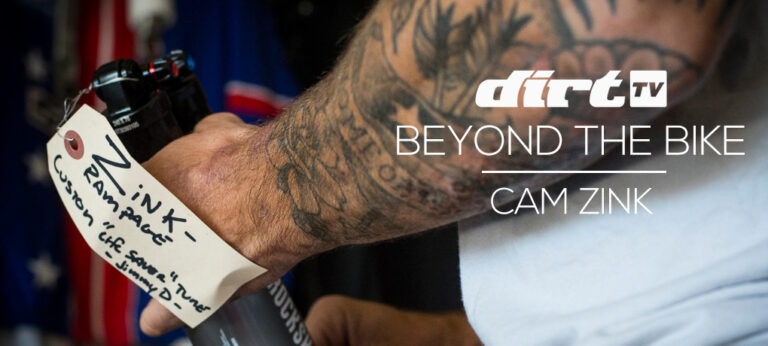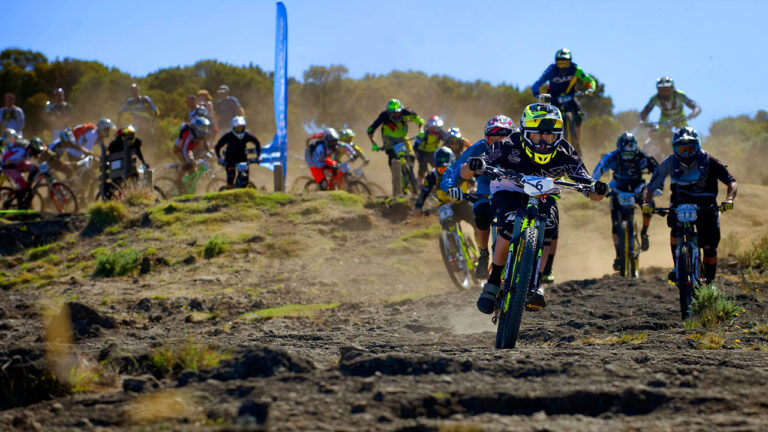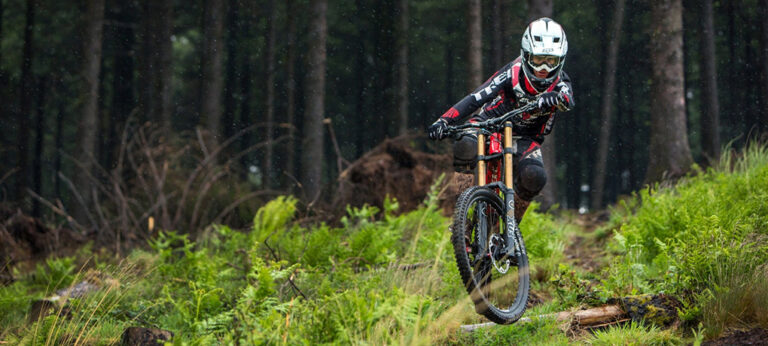
The only limit to the available grip on mud tyres is rider skill. Technique far outweighs the subtleties between brands of rubber, especially for hearty attacks into wholesome terrain. Sadly there are no trail bike specific tyres for real heavy mud conditions as are available for downhill bikes, and riders are compromised by having to use that rubber designed for long travel bikes which, when shod to lightweight wheels on mid travel bikes, confuses the weight balance and makes them only of any real use for gravity based riding…
From Dirt Issue 118 – December 2011
Words by Steve Jones. Photos by Steve Jones.
More than this, the ultimate off–camber grip offered by such tyres as Super Tacky Maxxis Wet Screams and Specialized Storms make them far too heavy and sticky for everyday trail riding, with their extremely aggressive edges and potentially adding 6–7lb onto your rims compared to say 2.3lb (plus tubes) of the lighter wet weather trail offerings. That said, there really is a world of difference in what you can get away with, yet the need for a more mixed condition pattern has led to a preoccupation of many downhill racers to pull out the snips and cut down…or choose rubber such as the Specialized Hillbilly or Maxxis Swampthing.
And it’s at that point that downhill largely meets trail, for most wet weather trail bike tyres focus around the fifty/fifty option – lighter (although harder) versions of the cut down spike but with a similar tread pattern. The discussion here will focus largely on these tyres.
SpecificityThe specific conditions need careful consideration when choosing tyres, after all mud tyre choice could be categorized by region. For example millstone grit/peat terrain demands a different approach to southern clays, which when saturated offers very little in terms of traction. Slightly watered super hardpacked singletrack and berms also present extremely difficult conditions. Sometimes there is a limit to grip. It becomes a game of limiting the risk. Tyre choice then, more so with wet weather conditions than dry, largely depends on the environmental conditions and a rider’s interpretation of it. This is especially true of the increasing bands of riders choosing to stay local, build trails that include all the natural elements, after all, riding the majority of trail centres could be done on slicks.
Rider AttitudeMany riders have the wrong attitude to riding in muddy wet conditions, thinking that the available grip is vastly different to that in the dry. This centres on trust. Or lack of it. With the available tyre technology, if anything, mud riding requires a far more aggressive approach, significantly more so with downhill mud rubber. For trail riding, mud on a root or rock, off–camber clay especially will always have less adhesion compared to dry conditions but still it’s a case of adjusting rider weighting, line choices, tyre pressure, damper settings…commitment and confidence.
SpecialistOur trail bike focus brings its own specialty – a need for speed on the flat, the amount of drag, the aggressiveness of the tread, the weight, sidewall thickness, tubeless compatibility and of course the cost. We’ll look into the need (or not) to spend the next six months tyre swapping or if there is a ‘fix–it tyre’. Are there different needs between 140 and 160mm bikes, what are the strength issues? Many questions.
Given there is a scarcity of factory cut–down spikes and 50/50 downhill tyres it’s not the case in the trail bike segment. There might be a lack of pure mud rubber but certainly not mid–ground conditions. However, as in downhill there comes a point when the cut–down becomes too compromised and where the fuller edge offered by the spike comes into its own. Where you ride, how you ride and what bike you ride matters. This is all down to conditions, skill levels and in terms of the bike such things as rim width – we found our skinniest tyre, the Continental Mud King, to work best with the non–tubeless, narrow Mavic rim.
Mixing tyresMany riders, in my opinion, choose the incorrect choice of having the grippier tyre up front in wet conditions. I think this might be something to do with motocross background a lot of the time. On a bicycle weight transfer is easiest to manage on the front of the bike, guiding a tyre through rock requires the first point of contact to be precise. Very simply a rounder profile 50/50 tyre up front is better suited for holding roots and rocks whilst the rear tyre can pretty much follow through. But it really is down to the variety on the trail, because looking at the wider picture is what counts. If the rock section is 50m long and the trail over two hours of sludge then you’re going to be better off with a more aggressive rubber both front and rear. Adjusting tyre weight up front in wet conditions is much easier than adjusting the amount of weight you are putting down on the rear. This is especially important on flatter off–camber sections (not to be confused with real steep DH off–camber). On hardpack that has been rained on you need the tyre to cut through; 50/50 tyres simply are not up to the task. In my view if you need a mud up front you’ll certainly need one on the rear.
Can they be used in the dry? Yes, in fact they are the best choice in some looser, dustier, sandy conditions. Fabien Barel, Nico Vouilloz, have all won World Cup events on wet tyres in dry dusty conditions. Sam Hill came to Wales and ruled the entirely rocky 1:04 track on cut–down spikes! On our test tyres on view here however I would be cautious with the more aggressive types as they simply fall over. Here then is our pick of the season’s best wet weather trail bike tyres.








